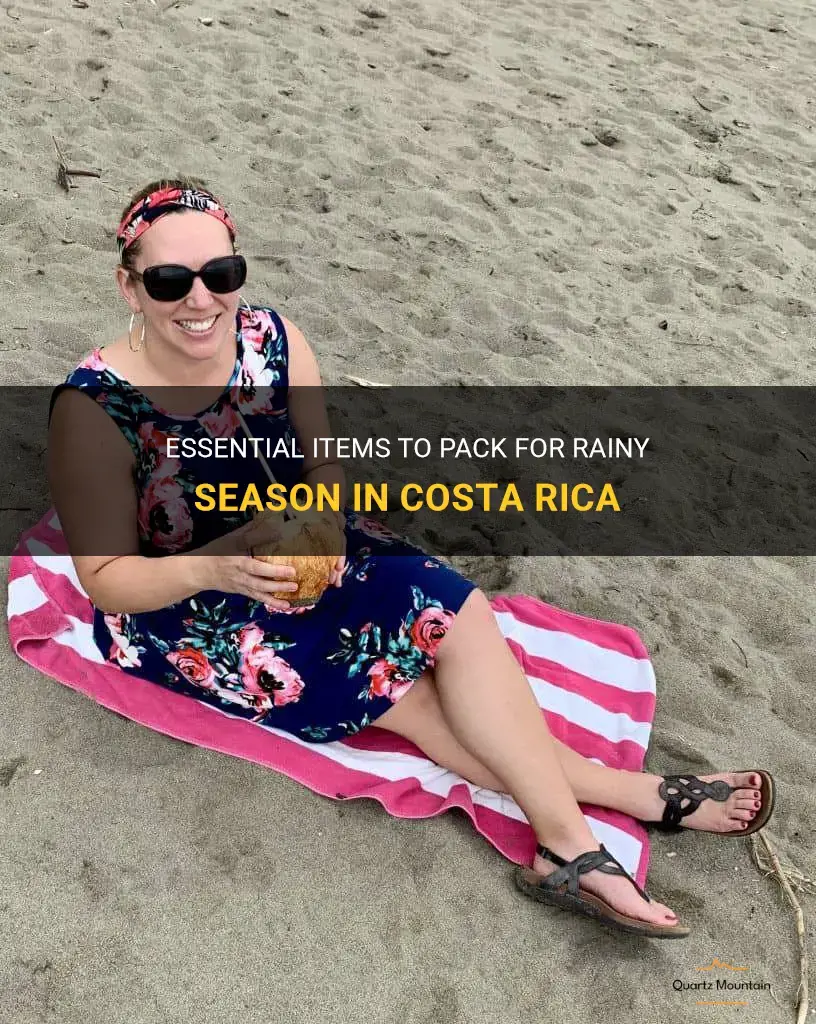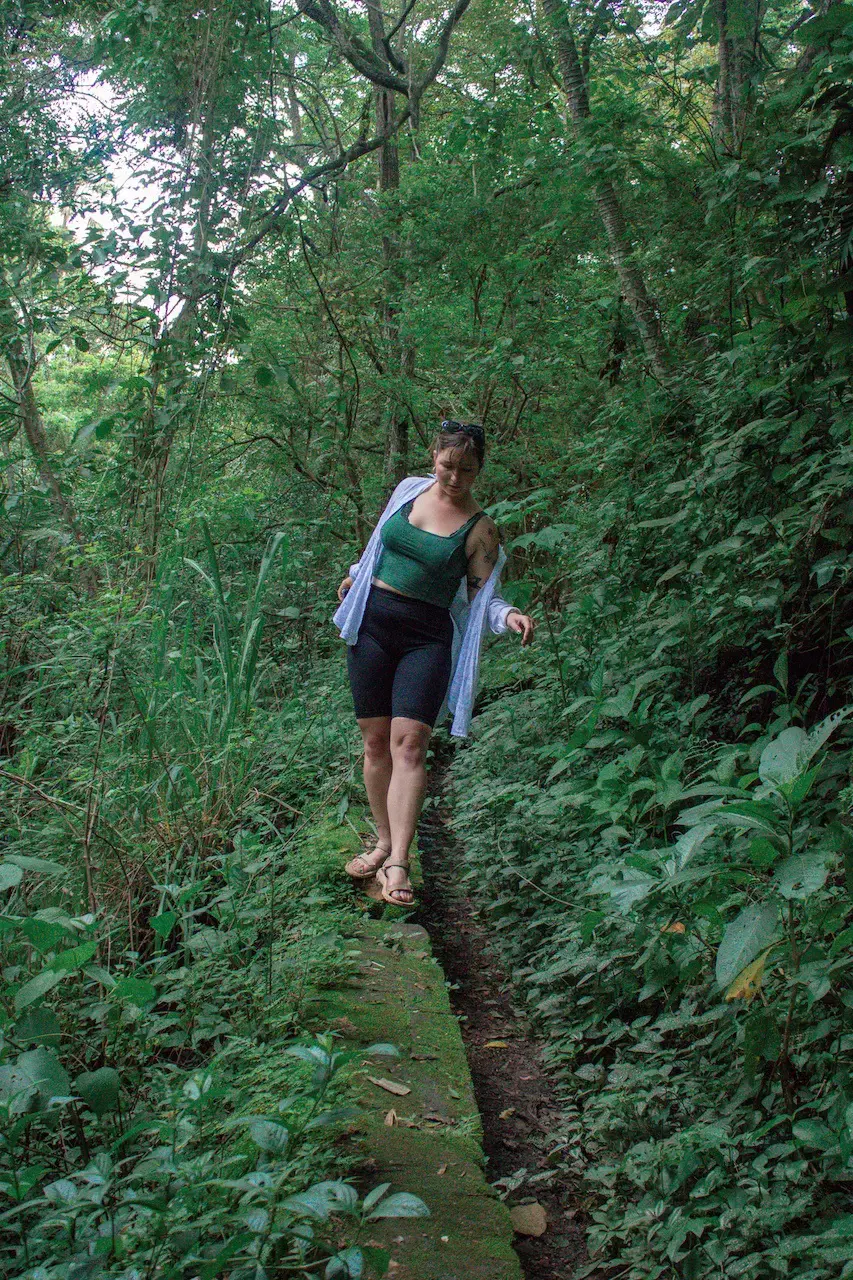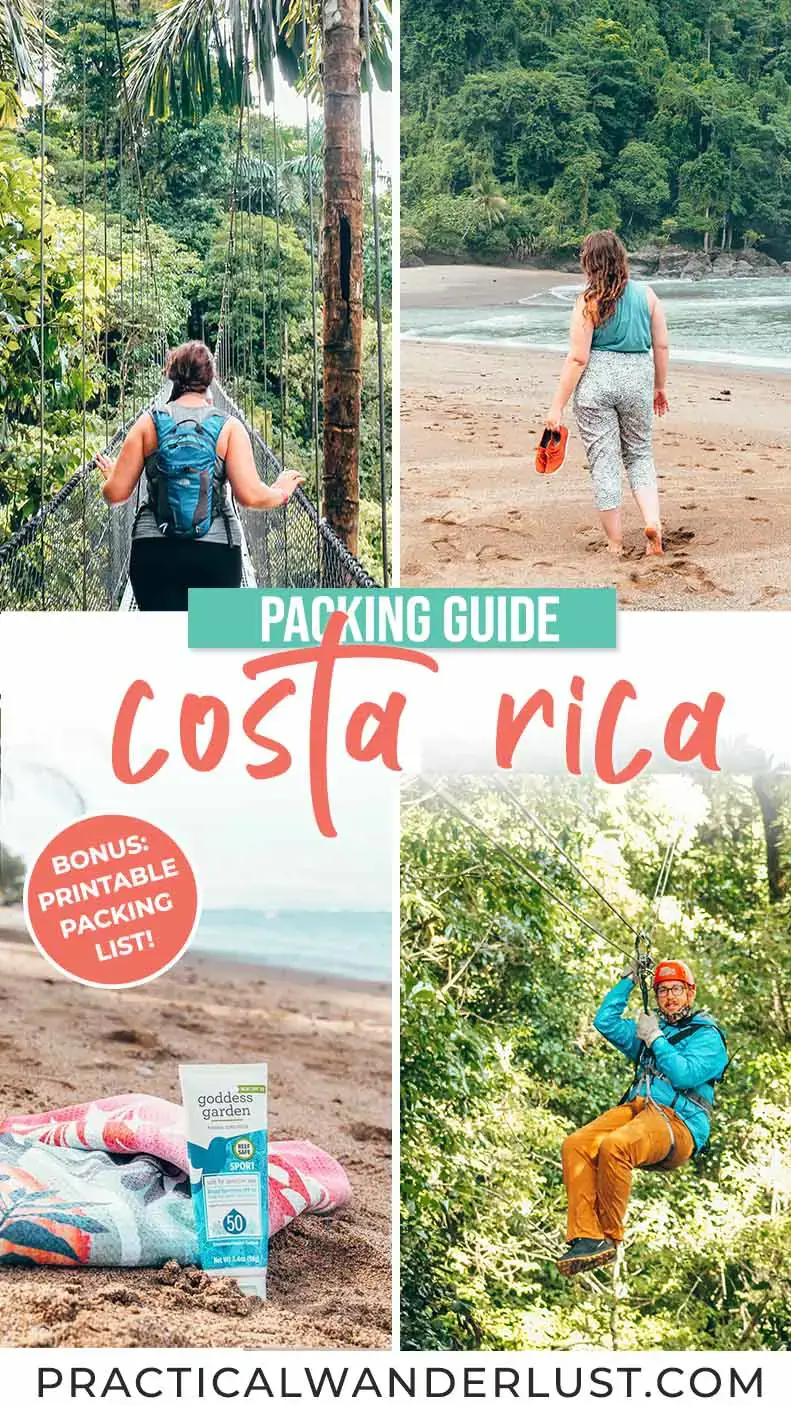
If you're planning a trip to Costa Rica during the rainy season, it's essential to pack the right items to ensure you stay comfortable and prepared. The country's lush rainforests and abundant waterfalls make for breathtaking scenery, but it also means lots of rain. From waterproof clothing to insect repellent, this guide will help you pack all the essential items you need to make the most of your rainy season adventure in Costa Rica.
| Characteristic | Value |
|---|---|
| Clothing | - Raincoat or waterproof jacket - Umbrella - Waterproof shoes or boots - Quick-drying pants or shorts - T-shirts or long-sleeve shirts - Extra socks |
| Accessories | - Waterproof backpack or daypack - Waterproof phone case - Plastic bags for wet items - Hat or cap to protect from rain - Sunglasses |
| Toiletries | - Waterproof sunscreen - Insect repellent - Lip balm - Travel-sized shampoo and conditioner - Small towel or microfiber towel |
| Electronics | - Waterproof camera or waterproof phone case - Power bank for charging electronic devices - Waterproof speaker - Waterproof watch - Travel adapters |
| Medications | - Personal prescription medications - Over-the-counter medications for common ailments (headache, allergy, etc.) - First aid kit - Motion sickness medication (if prone to it) |
| Other | - Plastic poncho or disposable rain poncho - Travel insurance - Cash (in case of power outages or difficulties with card payments) - Books or other forms of entertainment - Travel guide or map |
What You'll Learn
- What are the essential items to pack for the rainy season in Costa Rica?
- Are there any specific clothing items or materials that are recommended for the rainy season in Costa Rica?
- Is it necessary to pack rain boots or will regular shoes suffice?
- Are there any insect repellents or medications that should be included in a rain season packing list for Costa Rica?
- Are there any particular electronics or gadgets that are recommended to have on hand during the rainy season in Costa Rica?

What are the essential items to pack for the rainy season in Costa Rica?

Costa Rica is known for its lush rainforests and abundant rainfall, especially during the rainy season which extends from May to November. While the rain may provide a refreshing respite from the heat, it also brings its fair share of challenges. If you're planning a trip to Costa Rica during the rainy season, here are some essential items you should pack to ensure a comfortable and enjoyable experience.
Rain Jacket:
A good quality rain jacket is a must-have item when visiting Costa Rica during the rainy season. Look for a jacket that is waterproof and breathable to keep you dry and comfortable. Opt for a lightweight jacket that can easily be packed in your bag when the rain stops.
Waterproof Shoes or Boots:
The heavy rainfall in Costa Rica can quickly turn paths and trails into muddy and slippery surfaces. Invest in a pair of waterproof shoes or boots with good traction to help you navigate through the wet terrain. It is advisable to choose shoes that are comfortable for walking and provide ankle support.
Quick-Dry Clothing:
Packing quick-dry clothing is essential during the rainy season in Costa Rica. These fabrics are designed to dry quickly, allowing you to stay comfortable even if you get wet during your outdoor adventures. Avoid packing cotton clothing as it takes a long time to dry, making you feel cold and uncomfortable.
Waterproof Bag or Backpack:
Protect your valuables and electronics by packing them in a waterproof bag or backpack. This will ensure that your items stay dry even if you encounter heavy rain or accidental splashes. Look for bags that have waterproof seals or coatings to provide maximum protection.
Insect Repellent:
The rainy season in Costa Rica is also known for an increase in mosquito activity. Protect yourself from mosquito-borne diseases by packing insect repellent. Look for repellents that contain ingredients like DEET or picaridin, as these are known to be effective against mosquitoes.
Travel Umbrella:
While a rain jacket will keep you dry, a travel umbrella can provide additional protection during heavy downpours. Opt for a small, lightweight umbrella that can easily fit in your bag. This way, you'll have a backup solution in case the rain becomes too intense.
Waterproof Phone Case:
Keep your phone protected from water damage with a waterproof phone case. This will enable you to take photos and videos without worrying about rain or water splashes. Look for phone cases that are certified to be waterproof and provide a secure seal.
Travel Towel:
Pack a travel towel that is quick-drying and lightweight. This will come in handy when you need to dry off after getting caught in the rain or swimming in natural waterfalls or hot springs. Additionally, you can use it to cover your belongings or sit on during wet outdoor activities.
Extra Plastic Bags:
Having a few extra plastic bags in your backpack can be a lifesaver during the rainy season in Costa Rica. Use them to store wet clothes or shoes, separate wet and dry items in your bag, or protect your camera or other electronics from rain.
By packing these essential items, you'll be well-prepared to enjoy your trip to Costa Rica during the rainy season. Embrace the rain, explore the stunning rainforests, and make lasting memories while staying dry and comfortable. Remember to check the weather forecast before heading out and be prepared for sudden changes in weather conditions.
Essential Items to Include in Your Electric Picnic Packing List
You may want to see also

Are there any specific clothing items or materials that are recommended for the rainy season in Costa Rica?

The rainy season in Costa Rica, typically occurring between May and November, brings heavy showers and an increase in humidity. These weather conditions can have an impact on what clothing items and materials are recommended for this time of year. Here are some suggestions to help you dress appropriately and stay comfortable during the rainy season in Costa Rica.
- Lightweight and quick-drying materials: Opt for clothing made from lightweight and quick-drying materials such as nylon or polyester. These materials will dry quickly if you get caught in a rain shower and will also help wick away moisture from your body, keeping you comfortable even in high humidity.
- Waterproof or water-resistant outerwear: Having a waterproof or water-resistant outer layer is essential during the rainy season. A good rain jacket or poncho made from materials like Gore-Tex or nylon will help keep you dry in case of sudden downpours. Additionally, consider investing in a waterproof backpack or bag to protect your belongings.
- Breathable and moisture-wicking clothing: Choose clothing that allows your skin to breathe and wicks away moisture to keep you cool and comfortable. Cotton is not recommended as it tends to absorb moisture and can become heavy and uncomfortable when wet. Instead, look for synthetic fabrics or blends that are designed to keep you dry.
- Hats and umbrellas: Protecting your head from the rain is essential to stay dry and comfortable. Consider wearing a hat with a brim to shield your face and scalp from raindrops. Additionally, carrying a compact travel umbrella can help protect you from sudden showers without compromising your style.
- Quick-drying footwear: Invest in a pair of quick-drying shoes or sandals for the rainy season. Look for footwear made from synthetic materials instead of leather, as leather takes longer to dry and can become damaged when exposed to water. Waterproof hiking shoes or sandals with good traction will help keep your feet dry and prevent slips on wet surfaces.
- Layering: It is a good idea to layer your clothing during the rainy season, as the weather can be unpredictable. Start with lightweight, moisture-wicking base layers, add a breathable and quick-drying shirt, and top it off with a waterproof or water-resistant jacket. This way, you can adjust your clothing as the weather changes throughout the day.
- Avoiding light-colored clothing: Dark colors, such as navy blue or black, are less likely to show stains or water spots. Opting for darker clothing can help you maintain a cleaner appearance even if you get caught in a sudden rain shower.
Remember to check the weather forecast before heading out, as it can give you an idea of the day's conditions. While these recommendations can help you prepare for the rainy season, it is essential to be flexible and adaptable, as weather conditions can change quickly in Costa Rica.
A Comprehensive Guide on What to Pack for Medellin, Colombia
You may want to see also

Is it necessary to pack rain boots or will regular shoes suffice?

When it comes to packing for a trip, it's important to consider the weather conditions of your destination. One common question that arises when planning for a trip is whether it is necessary to pack rain boots or will regular shoes suffice. In this article, we will explore this topic using scientific reasoning, personal experience, step-by-step analysis, and real-life examples.
Firstly, let's consider the scientific aspect of the question. Rain boots are specifically designed to keep your feet dry in wet conditions. They are made of waterproof materials, which provide a barrier between your feet and the water. Regular shoes, on the other hand, may not have the same level of waterproofing. While some shoes may be advertised as water-resistant, they may not be able to withstand heavy rain or puddles. Therefore, from a scientific standpoint, rain boots would be the ideal choice to ensure dry and comfortable feet in rainy conditions.
Secondly, personal experience plays a crucial role in determining whether rain boots or regular shoes are more suitable. If you have traveled to a rainy destination in the past and wore regular shoes, you may have experienced discomfort or even soaked feet. On the other hand, if you have packed rain boots for a similar trip, you may have enjoyed the benefits of having dry feet throughout your journey. Drawing from personal experience, it is advisable to pack rain boots when visiting a rainy destination to enhance your overall comfort and enjoyment of the trip.
Now, let's break down the decision-making process step-by-step. Firstly, assess the weather forecast for your destination during your travel dates. If rain is predicted, it would be wise to pack rain boots as a precautionary measure. Next, consider the activities you have planned for your trip. If you anticipate walking or hiking in areas prone to wet conditions, rain boots would provide better traction and protection against slippery surfaces. Additionally, if you plan to explore nature parks or engage in water activities such as fishing or boating, rain boots would be essential to keep your feet dry and prevent any discomfort.
Furthermore, real-life examples can illustrate the necessity of packing rain boots. Imagine visiting a tropical rainforest where heavy rainfall is a regular occurrence. In such an environment, regular shoes would quickly become soaked and may even lead to blisters or infections. On the other hand, rain boots would allow you to walk comfortably through muddy trails without worrying about wet feet. Similarly, if you are visiting a city known for its frequent rain showers, such as London or Seattle, having rain boots would make exploring the city much more enjoyable as you can navigate through the wet streets without any inconvenience.
In conclusion, when deciding whether to pack rain boots or regular shoes for a trip, it is important to consider scientific reasoning, personal experience, step-by-step analysis, and real-life examples. While rain boots are specifically designed to provide waterproof protection and ensure comfort in wet conditions, regular shoes may not offer the same level of protection. By considering the weather forecast, planned activities, and the potential for discomfort or inconvenience, it becomes evident that packing rain boots is necessary to have a hassle-free and enjoyable trip in rainy destinations.
Essential Items to Pack for an Amazing Trip to Cyprus
You may want to see also

Are there any insect repellents or medications that should be included in a rain season packing list for Costa Rica?

When traveling to Costa Rica during the rain season, it is important to be prepared for the increased presence of insects. Mosquitoes and other biting insects tend to be more prevalent during this time, due to the higher levels of humidity and rainfall. To ensure a comfortable and enjoyable trip, it is essential to include insect repellents and medications in your packing list.
First and foremost, the primary insect repellent to include in your packing list is one that contains DEET (N, N-diethyl-meta-toluamide). DEET is the most effective active ingredient for repelling mosquitoes and other biting insects. Look for a repellent that contains at least 30% DEET for maximum protection. Apply the repellent to exposed skin and clothing, following the instructions provided by the manufacturer.
In addition to DEET-based repellents, it is also beneficial to pack mosquito netting. This can be used to cover your bed at night, providing an extra layer of protection against mosquitoes while you sleep. Mosquito netting is particularly useful if you are staying in open-air accommodations or in areas with a high mosquito population.
If you are concerned about the chemical content of insect repellents, there are also natural alternatives available. Repellents containing oil of lemon eucalyptus, citronella, or soybean oil are effective in deterring mosquitoes. However, it is important to note that these natural repellents may not provide the same level of protection as DEET-based products.
In addition to insect repellents, including antihistamine medications in your packing list can help alleviate the discomfort caused by insect bites. Antihistamines help to reduce itching, swelling, and redness that can occur from mosquito bites. Over-the-counter antihistamines such as diphenhydramine or cetirizine can be taken orally to provide relief from these symptoms.
It is also important to pack a corticosteroid cream or ointment to apply topically to insect bites. These creams help to reduce inflammation and itching, providing immediate relief. Be sure to consult with your healthcare provider or pharmacist to determine which corticosteroid cream is appropriate for you.
When traveling to Costa Rica during the rain season, it is also wise to wear long-sleeved shirts and long pants to minimize mosquito exposure. If you will be traveling to areas known for having a high population of mosquitoes, consider treating your clothing with permethrin. Permethrin is an insecticide that can be sprayed onto clothing, creating a protective barrier against mosquitoes and other biting insects.
Lastly, don't forget to pack an after-bite treatment. These treatments often come in the form of a gel or stick and contain ingredients such as ammonia or benzocaine to relieve itching and pain associated with insect bites. Applying an after-bite treatment immediately after being bitten can help alleviate discomfort and prevent excessive scratching.
In conclusion, when preparing for a trip to Costa Rica during the rain season, it is important to include insect repellents and medications in your packing list. DEET-based repellents, mosquito netting, antihistamine medications, corticosteroid creams, and after-bite treatments are all essential items to ensure a comfortable and enjoyable trip. Remember to follow the instructions provided by the manufacturer for proper application of insect repellents and consult with a healthcare provider or pharmacist if you have any medical concerns. With these precautions in place, you can protect yourself from insects and fully enjoy your time in Costa Rica.
What to Pack for Five Days in Italy during the Fall
You may want to see also

Are there any particular electronics or gadgets that are recommended to have on hand during the rainy season in Costa Rica?

With its tropical climate, Costa Rica experiences a defined rainy season, which typically lasts from May to November. During this time, it can rain heavily, leading to potential power outages and other electrical issues. Therefore, it is essential to have certain electronics and gadgets on hand to navigate the challenges of the rainy season. Here are some recommendations:
- Surge Protectors: Investing in surge protectors is crucial during the rainy season in Costa Rica. Thunderstorms can cause power surges that can damage connected devices. By using surge protectors, you can safeguard your electronics from sudden voltage spikes. Make sure to choose surge protectors that offer adequate protection for your specific needs.
- Uninterruptible Power Supply (UPS): An uninterruptible power supply is a device that provides emergency power to your electronics during a power outage. With a UPS, you can keep your essential devices, such as computers, routers, modems, and even medical equipment, running for a limited time until the power is restored or until you have backup power available. UPS units come in different sizes and capacities, so choose one that suits your needs.
- Waterproof or Water-Resistant Gadgets: When it comes to gadgets that you plan to use outdoors during the rainy season, it is essential to opt for waterproof or water-resistant models. This includes portable speakers, smartphones, cameras, and smartwatches. These gadgets are designed to withstand exposure to water, ensuring that you can continue using them even in wet conditions.
- Waterproof Storage Solutions: To protect your valuable electronics and personal belongings from water damage, consider investing in waterproof storage solutions. These can include waterproof bags, dry boxes, or even waterproof cases for smartphones and tablets. Having these storage solutions on hand allows you to keep your gadgets safe and dry, even if you get caught in a heavy downpour.
- Portable Backup Charger: Power outages are not uncommon during the rainy season. Having a portable backup charger can be a lifesaver, especially when you rely on your smartphone or other gadgets for communication or emergencies. Look for a portable charger with a high capacity battery so that it can recharge your devices multiple times before needing to be recharged itself.
- Wi-Fi Extenders: Rainy weather can weaken Wi-Fi signals, resulting in poor connectivity or dead spots in your home. A Wi-Fi extender can boost and extend your Wi-Fi coverage, allowing you to maintain a stable and reliable internet connection even during inclement weather. Choose a Wi-Fi extender with good range and compatibility with your existing router.
- Weather Monitoring Devices: Having a weather monitoring device can provide you with real-time information about the weather conditions in your area. This can help you stay informed about potential storms, heavy rainfall, or other weather-related hazards. Look for a weather monitoring device with features like temperature, humidity, and precipitation measurements for accurate forecasting.
By equipping yourself with these electronics and gadgets, you can be better prepared to handle the challenges that come with the rainy season in Costa Rica. Whether it's protecting your devices from power surges, keeping them dry during heavy downpours, or ensuring a stable internet connection, having the right tools can make a significant difference in your daily life. Stay safe and enjoy your time in Costa Rica, even when the rain starts pouring.
Essential Tips for Packing When Studying Abroad in Paris
You may want to see also
Frequently asked questions
When packing for the rainy season in Costa Rica, it is important to include a few key items. First, you'll want to bring a waterproof jacket or raincoat to stay dry during unexpected showers. Additionally, pack a pair of waterproof shoes or boots to protect your feet from getting wet and muddy. It's also a good idea to bring a travel umbrella or a compact rain poncho that can easily fit in your daypack. Lastly, don't forget to pack a waterproof bag or backpack to protect your belongings, such as your camera or electronics, from water damage.
Yes, it is a good idea to pack extra layers for the rainy season in Costa Rica. While the rain can bring cooler temperatures, the humidity can also make it feel warmer than usual. By layering your clothing, you can easily adjust your outfit to the changing weather conditions. Pack lightweight long-sleeve shirts and pants that can be worn on their own or layered with a sweater or jacket if needed. This way, you can stay comfortable throughout the day and be prepared for both rain and sunshine.
Yes, insect repellent and sunscreen are essential items to pack for the rainy season in Costa Rica. The rainy season is also known as the green season, which means there will be more mosquitoes and other insects present. To protect yourself from mosquito bites and potential diseases they may carry, apply insect repellent regularly. Additionally, even though it may be cloudy or rainy, the sun's UV rays can still be strong. Therefore, it is important to wear sunscreen with a high SPF to protect your skin from sunburn and long-term damage.







